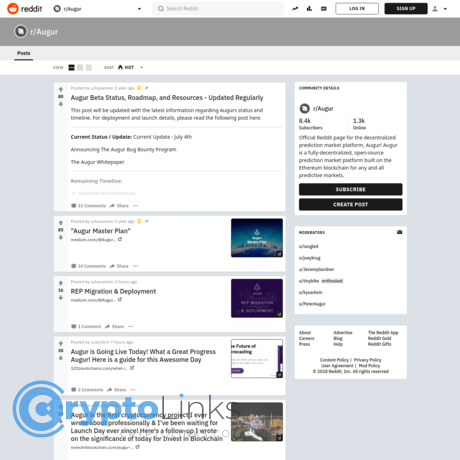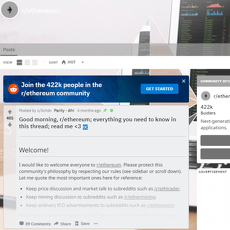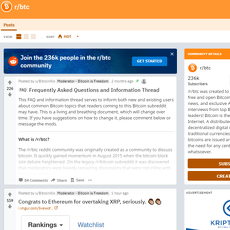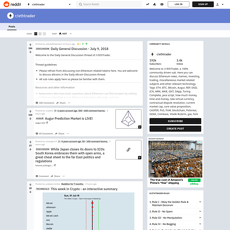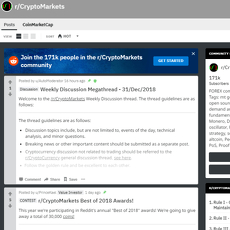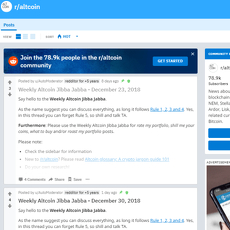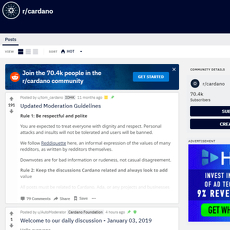r/Augur Review
r/Augur
www.reddit.com
r/Augur subreddit review guide: everything you need to know (+ FAQ)
Still wondering if r/Augur is worth your time in 2025 for learning about Augur, REP, and prediction markets? Or whether you’ll just run into old threads and dead links?
You’re not alone. I’ve spent a lot of hours in r/Augur and the broader prediction market world. In this guide, I’ll show you exactly what’s still useful on the subreddit, how to find it fast, and how to avoid the traps that waste your time.
By the end, you’ll know where to start, what to skip, and how to get crisp answers to the questions people actually care about: what happened to Augur, what the REP vs REPv2 story really is, whether there’s a future, and where the most informed conversations moved.
The problems most readers face with r/Augur and Augur info right now
The honest truth: r/Augur is a mix of valuable knowledge and outdated breadcrumbs. If you show up without a plan, you’ll bump into threads that don’t match today’s reality. Here’s what trips people up most:
- Outdated vs current posts: A 2019 answer about fees or UI won’t match a 2023–2025 setup. Always check timestamps and versions before following advice.
- REP vs REPv2 confusion: The token migration created a long tail of posts that sound correct but refer to the wrong token contract. Some exchanges and wallets still label things inconsistently. Example: Binance.US announced a REP delisting in Nov 2022, while other venues changed support at different times.
- Gas costs changed the product story: During key growth windows, Ethereum fees often hit double digits per on-chain action. That’s devastating for retail-size prediction markets. Historical gas data on Etherscan shows how volatile and expensive things got in 2020–2022, which explains a lot of “why didn’t this scale?” threads.
- UI links and front-ends that no longer work: You’ll find posts pointing to deprecated interfaces or domains from pre-L2 days. Following those links now can be a dead end.
- Liquidity fragmentation and market quality: Some old “example markets” looked active then but are ghost towns now. New readers often assume those snapshots still reflect current liquidity.
- Regulatory and geofencing headaches: Threads about U.S. user access and exchange support vary by date. What was okay then may be restricted now.
“Is my REP stuck on v1?” — You’ll see this question in multiple forms. The fix depends on when you asked, which wallet, and which token contract you actually hold.
There’s also a wider context worth knowing. Academic work shows prediction markets can be strong aggregators of information (see Wolfers & Zitzewitz, “Prediction Markets,” NBER), but crypto-native markets added new frictions: on-chain fees, UX complexity, and legal uncertainty. That gap between theory and practice is exactly what many r/Augur threads wrestle with.
My promise: a clear path to useful info in r/Augur, fast
I’ll keep things practical and laser-focused on what still helps you today. Here’s what you can expect next:
- How to search smart: The exact queries and sort options that surface reliable, up-to-date answers.
- Which flairs and stickies matter: So you don’t wade through noise or outdated debates.
- The top threads to read first: A short list that explains Augur’s arc without sugarcoating.
- Clear answers to the big questions: Why Augur struggled, what happened to REP/REPv2, whether there’s a future, and what Augur actually is in simple terms.
No hype, no recycling of half-true talking points. Just a practical route to signal over noise.
Who this guide is for, and what you’ll learn
This is for two kinds of readers:
- You’re new to Augur: You want a quick, accurate way to understand what it is, how the token fits in, and where to get trustworthy context without getting lost.
- You used Augur years ago: You remember REP, some migration chatter, and maybe the v2 release—now you want the 2025 reality check without catching up on hundreds of posts.
Here’s what you’ll take away:
- A fast refresher on the protocol: What Augur set out to do, how reporting works, and why incentives matter.
- A practical tour of r/Augur: How to sort, what to read first, and how to avoid dead links and outdated tutorials.
- Realistic expectations: What adoption looks like now, how gas and UX shaped outcomes, and how exchange support affects REP holders.
- Where the active chatter shifted: So you can monitor real progress and not just history.
Ready for the quick refresher that makes the rest of the guide click? In the next section, we’ll look at what Augur actually is today and how r/Augur fits into that picture—want the 60-second version or the deeper rundown?
Quick refresher: what Augur is and how r/Augur fits in
Think of Augur as an on-chain market engine for questions about the future. People create markets, traders buy and sell outcomes, and a decentralized oracle decides which outcome is true. The glue is REP/REPv2, the token reporters stake when they resolve events. The subreddit is where that whole lifecycle got discussed in public: releases, bugs, market design, reporting wars, and “what went wrong, what went right” threads.
“Prediction markets aren’t just bets; they’re information compression machines.” — a line I keep coming back to, echoing research by economists like Justin Wolfers and Eric Zitzewitz
What is the Augur protocol?
At its core, Augur is an open-source prediction market protocol built on Ethereum. Here’s the practical flow:
- Create: Anyone can spin up a market (Yes/No, multiple choice, or scalar like “BTC price at month-end”). Templates helped reduce invalid markets by standardizing wording.
- Trade: Traders buy and sell outcome shares. Prices reflect the crowd’s probability estimate.
- Resolve: After the event, reporters stake REP (migrated to REPv2) to signal the truthful result. Disputes escalate in rounds until consensus sticks, aligning incentives toward honesty.
History you’ll see referenced on r/Augur:
- Augur v2 (2020): A major overhaul with new contracts, the move to REPv2, market templates, and a new reporting flow.
- Augur Turbo (2021): A push toward faster, cheaper markets on Polygon to blunt Ethereum gas pain and make “daily-life” markets (sports, crypto events) cheaper to use.
- Reporting mechanics: Dispute rounds, bonds, and fork threats exist to punish manipulation and reward accuracy. It’s game theory hardened by capital at risk.
Why any of this matters: there’s strong evidence that markets can aggregate information efficiently. Classic references include the Iowa Electronic Markets’ election accuracy (University of Iowa) and research showing prediction markets often outperform polls in certain settings (NBER paper by Wolfers & Zitzewitz). Augur aimed to bring that power on-chain without a single company controlling the outcomes.
Real examples you’ll stumble upon in old threads:
- Yes/No: “Will ETH complete the Merge in 2022?”
- Multiple choice: “Which party will control the U.S. Senate after the election?”
- Scalar: “What will BTC’s closing price be on 31 Dec 2025?”
Each design changes liquidity needs, UX, and how costly it is to get reliable resolution data. That’s the stuff power users debated constantly on the subreddit.
r/Augur at a glance: purpose, rules, and post types
The subreddit is the public notebook of Augur’s life cycle—warts and wins included. Before you scroll, hit the rules in the sidebar to avoid low-effort posts or spam: r/Augur.
What you’ll typically see:
- Release notes: Version announcements, UI updates, REP/REPv2 migration reminders, and links to GitHub tags.
- How-tos: Market creation tips, templates to avoid “Invalid,” reporting step-by-steps, bond sizing explanations.
- Support and bug threads: Transaction stuck? UI link deprecated? Error code screenshots with quick replies from power users.
- Gas and UX debates: Why trading or resolving was too expensive on L1, and whether L2s or Polygon actually fixed it for everyday markets.
- Governance and listings: Heads-up posts when exchanges changed support for REP, or when community policies shifted.
- Post-mortems: Some of the most useful content—breakdowns of liquidity struggles, invalid market incentives, and what should have shipped earlier.
Useful breadcrumbs you’ll notice in good threads:
- Links to specific contract addresses and version tags
- Template IDs and examples that reduced invalid outcomes
- Comparisons between the old UI and newer L2/Polygon flows
When a comment explains how a “Yes/No” market got deemed “Invalid” due to vague wording—and then shows the template that fixed it—you’re looking at hard-earned learning you won’t find in polished docs.
Activity level and signals to watch in 2025
Traffic is quieter than it used to be, but the signal hasn’t vanished. Here’s how I read the room quickly:
- Sort by Top → Year: Pulls up the enduring explainers and post-mortems people still reference.
- Check “New” briefly: You’ll catch fresh support fixes, UI path changes, and any maintenance updates.
- Scan mod stickies: They anchor the current context—what’s supported, where to report bugs now, where docs actually live.
- Look for REP/REPv2 clarity: Any thread that cleanly explains the migration path and current token addresses is worth bookmarking.
- Follow links out: If a post points to an active GitHub issue or a living docs page, that’s your breadcrumb to what’s still maintained.
I still see gems surface: someone documents a Polygon flow with gas numbers, another shares a reporting dispute timeline that clarifies costs and incentives, and a third compares price discovery on Augur vs. a centralized venue. Those threads save hours if you’re learning how prediction markets actually behave when the rubber meets the road.
Curious how to cut straight to those high-value threads without wading through the noise? I’ve got a simple search-and-sort play that consistently surfaces the good stuff—plus the flairs that matter and the red flags that waste your time. Want the exact steps I use every week?
How to use r/Augur efficiently (so you don’t chase dead ends)
I treat r/Augur like a library with some shelves mislabeled. The goal is to grab the right books fast, ignore the dusty ones, and leave with answers in minutes. Here’s the workflow I use when I want current, useful info without wasting an evening.
“Trust the community — but timestamp everything.”
Search and sort tips that actually work
Reddit’s native search can be hit-or-miss. I mix Google operators with Reddit filters to get straight to the good stuff.
- Start with Google for precision — it’s faster and more forgiving than Reddit search:
- site:reddit.com/r/Augur REPv2 migration — for token migration threads
- site:reddit.com/r/Augur "market templates" — for invalid-market avoidance and resolution clarity
- site:reddit.com/r/Augur release OR changelog — to catch version announcements
- site:reddit.com/r/Augur gas Polygon OR L2 — to avoid pre-L2 gas advice
- Use minus filters to strip noise: site:reddit.com/r/Augur REP -giveaway -airdrop
- Then pivot inside Reddit:
- New for live fixes and support: r/Augur/new
- Top for timeless frameworks: r/Augur/top/?t=all
- Use the time filter strategically: set to “Past year” for anything operational (UI links, gas, exchange notes)
- Run a 60‑second “is this current?” check:
- If the post predates Polygon/L2 mentions, treat gas numbers and UX steps as archive material
- If comments reference migrating from REP to REPv2, note the year — migration posts around 2020 solve different problems than Polygon-era threads in 2021+
- Look for version tags (v2, Turbo) and pinned mod context before following any how-to
Why this matters: link and instruction decay on social platforms is real. Analyses of public web content show “link rot” is common over time, and social posts have short half-lives. Translation: old setup guides and UI links often mislead. Sorting by New and time-filtering weeds out most of those traps in seconds.
Flairs, stickies, and best-of threads to read first
The fastest route to clarity is to let the mods and power users pre-sort the reading for you.
- Start with the stickies at the top of the subreddit (green pin). These typically include:
- FAQ and “read this first” context
- Release or migration announcements
- Bug megathreads for current UIs
- Click a flair to filter (on desktop, tap the flair badge on any post):
- flair_name:"Release" sorted by Top — version changes, feature introductions
- flair_name:"Support" sorted by New — live issues and fixes
- flair_name:"Discussion" Top (year) — durable market design takes
- Build a 10‑minute “best-of” reading list:
- Top (All Time): look for posts that explain reporting incentives, invalid markets, and market templates with examples
- Top (Year): scan any post referencing Polygon/L2 or updated UIs to anchor yourself in current mechanics
- Latest pinned release: skim the comments for gotchas users discover on day 1 (these often save hours)
Save these filtered views once, and you’ve basically turned r/Augur into your personal dashboard.
Red flags and common pitfalls
Some mistakes cost time; a few can cost money. Here’s what I ignore on sight and what I double-check.
- Outdated exchange notes
- Any post listing exchanges from years ago might be wrong today; verify listings and tickers (REP vs REPv2) on the exchange and on a block explorer
- Match the token contract address on Etherscan or Polygonscan before moving funds
- Dead or deprecated UIs
- Posts that point to old hosted frontends or IPFS hashes can be stale; if a link errors, search the subreddit for the latest official frontend mention or check the project site/GitHub
- Pre-L2 gas assumptions
- Threads complaining about $50+ trade costs are usually pre-Polygon context; don’t copy their workarounds unless the date matches the chain you’re on
- Market resolution confusion
- Examples created without templates (older posts) are more prone to “Invalid” outcomes; favor template-based examples and newer resolution discussions
- Too-good-to-be-true “staking” or airdrop claims
- REP is for reporting and dispute resolution, not passive yield; be suspicious of any post promising returns for locking REP
- Support DM scams
- Post a support question and fake helpers may DM you; never share seed phrases or sign blind transactions — insist on public, verifiable replies
Here’s a quick, repeatable 15‑minute workflow I use when I need an answer fast:
- Minute 1–3: Run two Google searches (migration or release + your exact error/term)
- Minute 4–6: Open r/Augur “Top (Year)” and the latest sticky; scan for matching terms
- Minute 7–10: Filter by flair (Support or Release) and sort appropriately
- Minute 11–15: Cross-check any instructions against dates, token contracts, and whether the thread references Polygon/L2
Do this and you’ll skip 90% of the noise. And if you’re still wondering about the big recurring questions everyone asks — why growth stalled, what exactly happened to REP across exchanges, and whether there’s a future worth tracking — keep reading. The straight answers are next.
FAQ from the subreddit: straight answers to the big questions
Every time I scan r/Augur, I see the same four questions. Here’s the blunt, current version of the answers — no marketing gloss, just what actually matters if you’re trying to understand Augur in 2025.
“It wasn’t the idea that failed; it was the cost of pressing the button.”
Why did Augur “fail” or struggle to grow?
The short answer: timing and frictions. The product tried to scale during the worst possible fee environment on Ethereum, while UX and liquidity never quite clicked.
- Gas costs killed casual use. A typical flow (approve collateral → approve contract → place order → cancel/modify → claim → settlement) could mean 5–10 transactions. During 2020–2021, that often meant $30–$100+ in fees for a small position. If you remember paying ~$20 just to cancel an order, you weren’t alone. Check the context on the Etherscan Gas Tracker — the spikes line up with the subreddit’s “this is unusable” threads.
- Clunky UX and too many steps. Early Augur required technical patience: market templates, approvals, disputing/reporting flows, and careful gas settings. Great for tinkerers; rough for everyone else.
- Liquidity fragmentation. Many markets had thin books and noticeable slippage. Prediction markets live and die by depth; the “long tail” of markets didn’t get the traction needed to keep traders around.
- Regulatory uncertainty, especially for U.S. users. The chill mattered. While the protocol is permissionless, traders don’t want to worry about whether they can even access a front end tomorrow.
- Competition moved faster on UX and cost. Retail-friendly platforms on cheaper rails became the default for new users. Public dashboards regularly showed those volumes dwarfing anything on Augur, especially through 2024’s election cycle.
To be fair, there were smart pivots — L2 experiments and simplified market types — but they arrived after behavior had already shifted elsewhere.
What happened to REP and exchange support?
Two things tripped up a lot of holders: the token migration and changing exchange listings.
- REP → REPv2 migration. When Augur v2 shipped, it introduced REPv2 as the reporting token. Holders of legacy REP could migrate 1:1 to REPv2. Reporting on v2 relies on REPv2, not the old REP.
- Tickers can be confusing. Some venues still show “REP” as the ticker even if they support the v2 contract. Always verify the contract address, not just the ticker.
- Delistings happened. For example, Binance.US announced a REP delisting in November 2022. Other exchanges adjusted markets or liquidity over time. Before you move funds, confirm that your venue supports deposits/withdrawals for the version you hold.
Contract addresses to sanity-check (always verify on Etherscan, not random threads):
- Legacy REP (v1): 0x1985365e9f78359a9B6AD760e32412f4a445E862
- REPv2: 0x221657776846890989a759ba2973e427dff5c9bb
Practical checklist if you still hold REP:
- Confirm your token’s contract on your wallet and on Etherscan.
- If it’s legacy REP, check the official docs or repository notes for the current migration path and status. Test with a small amount first.
- Before sending to an exchange, read the exchange’s latest REP/REPv2 support page and a recent user thread to catch surprises.
One last note I often repeat on the subreddit: custodial platforms can label things however they want; your wallet and the chain don’t lie.
Does Augur have a future?
It depends on three levers: cost, liquidity, and simplicity. Cheap transactions (L2 or otherwise), a UX that hides the plumbing, and enough depth to keep spreads tight — if those align, there’s still a niche for truly permissionless markets. Some community members believe the best chance is a focused product on an L2 with a few sticky market types (sports, major events), then gradually expanding.
The counterpoint on r/Augur is blunt: the crowd and the conversation moved. Competing platforms captured mindshare, creator flows, and market-makers during the crucial 2021–2024 window. Public data showed their volumes compounding while Augur’s threads shifted toward support, history, and post-mortems.
Where does that leave you today? Watch for signs of real momentum: shipping velocity, active front ends, and visible liquidity providers stepping in. The subreddit still flags meaningful releases when they happen — the question is whether those releases turn into active markets rather than just code updates.
What is the Augur protocol, in simple terms?
It’s a trust-minimized way to bet on outcomes without a central bookie. At a glance:
- Markets: Anyone can create a market with clear, verifiable resolution criteria.
- Trading: Traders buy and sell outcome shares; prices reflect probabilities.
- Resolution: After the event, reporters stake REP/REPv2 to report the truth. Wrong reports can be disputed at a cost; incentives push toward the correct outcome.
- Payouts: Once finalized, winning shares can be redeemed for collateral.
Think of it as a marketplace for “what happens next” where the settlement process is enforced by economic skin in the game instead of a company’s promise.
Curious how to verify whether there’s actual progress behind the scenes — code, commits, and places where the prediction crowd is talking right now? That’s exactly what I unpack next, with the links I use to sanity-check it in minutes instead of hours.
State of play: development, community, and alternatives to monitor
If you’re trying to figure out what’s real with Augur right now, think of r/Augur as the public ledger of lessons learned. It’s great for context and breadcrumbs, but you still need to confirm what’s active today. Here’s how I keep my signal-to-noise ratio high.
Development and releases: how to sanity-check progress
Release posts on r/Augur can point you in the right direction, but I always verify the trail. A few quick checks will save you from following a dead UI or an abandoned branch.
- Start with the date → version → link triage: Note the version in a release post, the publish date, and any links to app/docs. If the links 404 or redirect to a generic page, treat that as a flag.
- Hop to GitHub and scan for life: Search the project’s organization on GitHub. Check:
- Recent commits: anything in the last few months?
- Release tags: are there versioned releases that match what you saw on Reddit?
- Open issues/PRs: are bug reports answered and merged, or piling up?
- Security notes: any advisories or dependency alerts left unresolved?
- Match UI to chain activity: If a post mentions a new deployment (for example, “Turbo” or an L2 move), check a block explorer. On Etherscan/Polygonscan:
- Look up the market factory or resolver contract mentioned in docs.
- Sort by latest transactions to see recent market creations or settlements.
- Confirm token addresses (REP vs REPv2) from the official repo or docs before moving funds.
- Docs are your checksum: Compare any how-to from Reddit with the current docs site. If the docs reference deprecated endpoints or old wallets, don’t rely on that path.
- Audit and oracle posture: Search the repos and docs for “audit,” “bug bounty,” and “oracle.” If you can’t find up-to-date security notes, size your risk accordingly.
“Markets are where opinions go to get priced.” The code behind them is where trust goes to get earned.
One more sanity tip: if someone posts a fix and there’s no corresponding commit, tag, or on-chain change within a reasonable window, treat it as unverified. Good projects leave trails.
Where the prediction market crowd hangs out now
r/Augur is still useful for historical context and the occasional pointer, but most real-time chatter happens elsewhere. I keep a short list of “live wires” and check them before I assume anything is dead or active.
- GitHub issues and Discussions: You’ll often see design debates, bug triage, and release candidates here first.
- Discord servers: Project-specific Discords for Augur-adjacent tooling, or communities for competing platforms, are where builders answer support questions fast.
- X/Twitter: Follow core contributors, protocol accounts, and researchers who cover forecasting, oracles, and on-chain markets. Lists help filter hype.
- Research hubs: Academic and practitioner circles track forecasting accuracy and market design. When I see a claim on social, I look for a supporting write-up.
Why does this matter? Because the value of a prediction market hinges on three moving parts: liquidity, oracle reliability, and user experience. The people who push those forward tend to ship and talk off Reddit first, then circle back.
Alternatives people compare with Augur
If you’re trying to understand where traders and forecasters actually spend their time now, these names come up a lot alongside Augur:
- Polymarket — retail-friendly, fast UX
- Where it shines: real-world event markets, quick onboarding, active liquidity on popular topics.
- What to verify: geographic and KYC restrictions, fee structure, and how the settlement source is defined.
- Why people cite it: speed and selection. Traders looking for news-driven action compare their experience here to what Augur aimed for.
- Omen on Gnosis — modular, oracle-flexible
- Where it shines: low fees on Gnosis Chain, community-curated markets, and flexible oracles like Reality.eth.
- What to verify: which oracle a market uses, liquidity depth, and dispute windows.
- Why people cite it: it showcases AMM-style liquidity for prediction markets and a different governance flavor than Augur’s REP-based reporting.
- UMA-based markets — Optimistic Oracle, bespoke markets
- Where it shines: configurable resolution criteria, KPI-style markets, and composability with DeFi.
- What to verify: dispute timelines, proposer/bond requirements, and exact settlement language.
- Why people cite it: a different take on oracle incentives that informs how folks think about Augur’s design trade-offs.
- Metaculus — non-crypto forecasting culture
- Where it shines: strong forecasting community, Brier/METRICS-based scoring, and well-defined question standards.
- What to verify: not a trading venue; use it for crowd intelligence and question design inspiration.
- Why people cite it: it sets the bar for question clarity and calibration — lessons Augur market creators can borrow.
If you like receipts: years of research suggest prediction markets can be well-calibrated and sometimes beat polls when incentives and question wording are tight. A good primer is Wolfers & Zitzewitz’s “Prediction Markets” (Journal of Economic Perspectives, 2004) — you can find it on SSRN. Those findings echo what I see on-chain: clear resolution rules plus cheap transactions bring traders; ambiguity and high costs chase them away.
One caution across all options: check your local rules. Some platforms restrict U.S. users or require KYC, and enforcement actually happens.
So, how do you turn all this into a fast, repeatable workflow that keeps you out of dead ends and into live info? In the next section, I’ll share the exact playbook I use — want the 10-minute checklist that never fails me?
My practical playbook: getting value from r/Augur in 2025
For research and learning
I use a simple 20–minute routine to separate signal from noise and walk away with facts I can trust.
- Start with “Top → All Time,” then “Top → Past Year.” The all-time view surfaces the best frameworks and post-mortems. The past-year view shows what still matters today. Scan titles and upvote counts, but always click through for dates and links.
- Run targeted searches with date filters: I use Reddit’s search like this: site:reddit.com/r/Augur REPv2 migration, site:reddit.com/r/Augur Turbo Polygon, site:reddit.com/r/Augur reporting dispute, site:reddit.com/r/Augur gas fees. Then I pivot to “New” if I’m chasing fixes, or stay on “Top” for evergreen explanations.
- Do the 3-tab crosscheck (always):
- Tab 1: the Reddit thread
- Tab 2: official docs or help center (e.g., templates, reporting rules)
- Tab 3: GitHub repos and recent commits for the relevant UI or contracts
If a thread references a specific UI URL or contract, I verify it in Tab 3. Dead links happen; active repos and recent tags don’t lie. - Verify anything token-related twice. Any mention of REP vs REPv2 or exchange listings gets cross-checked against a live exchange page or an official notice. Old posts often assume support that no longer exists.
One reason I lean on “Top” for learning is that prediction market dynamics haven’t changed as much as UX and fees. Academic work supports this: multiple studies show well-structured prediction markets aggregate information efficiently under reasonable liquidity. For a timeless primer, see Wolfers and Zitzewitz (Journal of Economic Perspectives) on how markets synthesize dispersed beliefs into prices, and the Iowa Electronic Markets’ research archive on forecast accuracy:
“Prediction markets frequently produce probability forecasts that are at least as accurate as those from alternative methods.” — Wolfers & Zitzewitz (NBER) • Iowa Electronic Markets research
Those papers won’t teach you how to click through a front end, but they’ll calibrate your expectations: a subreddit gives context; a functioning market and its order book give probabilities.
For troubleshooting and market mechanics
When something breaks, I want answers fast. Here’s the play I run.
- Search the exact error text. Quotes work wonders: “insufficient allowance”, “wrong network”, “price out of bounds”, “reporting window closed”, “chain id mismatch”. Add site:reddit.com/r/Augur and, if relevant, Polygon or Optimism.
- Confirm the UI isn’t deprecated. If a thread links to a front end, I check:
- Does the page load over HTTPS with a valid cert?
- Is there a footer link to docs or a GitHub repo with commits in the last 6–12 months?
- Is the chain selector (if any) aligned with what the docs say? If a guide says Polygon but the UI wants mainnet, that’s a red flag.
- Check the obvious wallet toggles. Most “it’s broken” reports boil down to:
- Wrong network selected (e.g., on Ethereum when the UI expects Polygon).
- Allowance/approval missing for the quote asset (e.g., USDC).
- Slippage or tick-size out of range for that market template.
- When posting a support question, give version context up front:
- Wallet + version (e.g., MetaMask 11.x), browser, OS
- Network (Ethereum mainnet, Polygon, etc.) and chain ID
- UI link, market URL/ID, and any tx hash
- Exact error message
This cuts the back-and-forth and gets you quality replies faster.
Pro tip: If a fix worked for someone in 2021 on Polygon, but you’re on a different chain or a different front end, treat it as a clue, not gospel. I often paste a suspected contract into Etherscan or Polygonscan to confirm it’s verified and matches what the UI shows.
For trading or speculating decisions
I treat r/Augur as a place to understand mechanics, not as a signal generator. Before risking funds, I run this checklist:
- Is the market live where you can actually access it? Double-check geo restrictions and whether the front end you plan to use is operational and compliant for your region.
- Is there real liquidity? Click through to the order book, not just the chart. Thin books = wide spreads and painful slippage. If possible, confirm open interest and volume on-chain or via a reputable dashboard.
- Fees and routing. Execution isn’t just the taker fee; consider approvals, gas (or L2 costs), and any bridge steps. Sum it all before you trade.
- Resolution and oracle rules. Read the market template and resolution criteria word-for-word. Many losses come from ambiguous wording, not “bad predictions.”
- Cross-validate the thesis. If a thread claims “X event is mispriced,” I sanity-check with independent sources: reputable news, polling aggregators, or expert forecasts. Research shows markets can be strong aggregators, but low-liquidity environments can distort prices; the Wolfers & Zitzewitz review explains these limits well.
Outside crypto-native markets, I sometimes glance at forecasting communities to pressure-test assumptions. Good Judgment’s research and the broader literature on expert calibration are helpful guardrails when emotions creep in:
“Consistency and regular updating beat loud certainty.” — Good Judgment research library
One last thing before we move on: do you want the quick verdict on whether r/Augur is still worth a subscribe in 2025—and who should skip it entirely? That’s exactly what I’m unpacking next, along with the fastest next steps so you don’t waste a single click.
Verdict, quick hits, and your next steps
Here’s the short version: r/Augur still earns a spot in my bookmarks as a reliable archive and an occasional pulse check. It’s not where active prediction market traders spend their days, but it is where you’ll find the backstory, the migration breadcrumbs, and the threads that explain why things unfolded the way they did.
Real sample of what it’s good for: I pulled an old migration sticky to trace REP → REPv2 decisions, then checked a Polygon-era “Turbo” release post to understand how the team tried to cut costs on L2. That context still saves me time when I compare current platforms and mechanics.
Pros and cons at a glance
- Pros
- Honest community analysis you won’t get in glossy marketing posts.
- Sticky FAQs and release threads that explain REP/REPv2, reporting, and oracle design.
- Useful links to code, docs, and past UIs that show what actually shipped.
- Cons
- Lighter activity, so some questions sit unanswered.
- Outdated how-tos from pre–L2 days that no longer match current workflows.
- Shifting token/exchange details that require fresh verification every time.
Who should subscribe (and who shouldn’t)
- Subscribe if you’re researching prediction market design, tracing REP history, or want archived answers on reporting and dispute mechanics.
- Skip (or just lurk) if you’re after high-volume trade chatter, price calls, or real-time market edges. You’ll find that energy on active platforms and their chats.
Quick hits that actually matter
- Expect quiet weeks. When a new post lands, it’s usually a release, a bug thread, or a “what happened to REP?” question worth scanning.
- Old UI links and exchange notes can mislead you. Treat every link like a museum label: check the date first.
- Use it to understand the why behind design choices. That perspective pays off when you compare with today’s platforms.
What the broader data says (and why that still matters)
Prediction markets as a concept aren’t dead; the user base shifted. Public dashboards show strong 2024–2025 activity on retail-friendly platforms (Dune: Polymarket is a useful reference). And yes, the academic backdrop still supports the idea that markets can aggregate information well—see accessible overviews like Wolfers & Zitzewitz’s work on prediction markets (NBER) and the track record of the Iowa Electronic Markets. That’s why I keep r/Augur on hand: it documents the trade-offs that next-gen platforms are trying to fix.
Rule of thumb I use: if a thread mentions gas estimates that assume mainnet-only usage, or links to a deprecated Augur UI, I treat it as history, not a playbook.
Your next steps
- Bookmark r/Augur for reference and scan new posts monthly. It won’t flood your feed, and the occasional update is worth it.
- Cross-check anything procedural against current code and docs: GitHub and the latest docs or site you use.
- Verify token listings before moving funds. Check live markets pages for REP/REPv2 and confirm tickers on your exchange of choice.
- Track where traders actually are: follow active communities and dashboards (for example, Polymarket analytics, Omen/Gnosis channels, and non-crypto forecasting hubs like Metaculus).
- Keep an eye on L2. If you see credible posts about lower fees or new deployments, validate them and test with small amounts first.
Final word
Use r/Augur as a smart reference, not a single source of truth. Check dates, confirm listings, and compare notes with live platforms and L2 roadmaps. That simple workflow keeps me accurate, saves me hours, and helps separate what’s historical from what’s actually actionable today.

